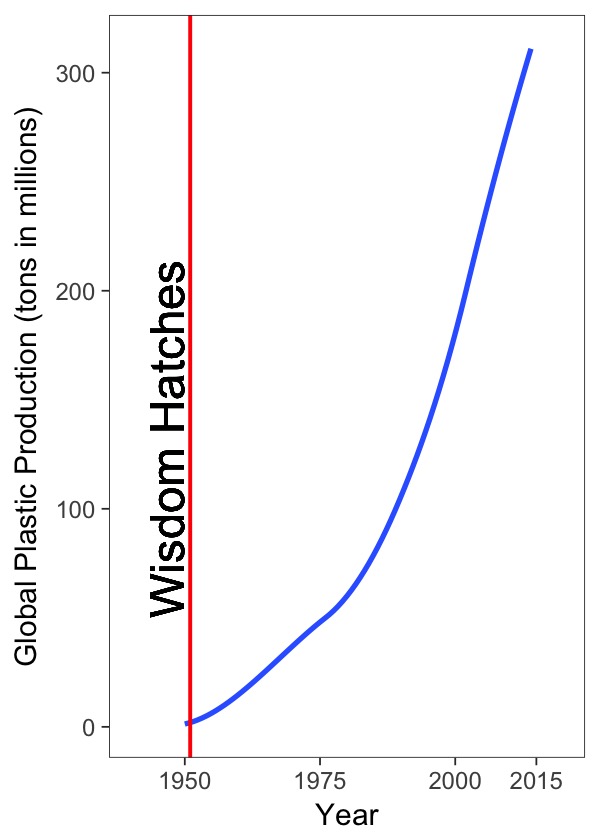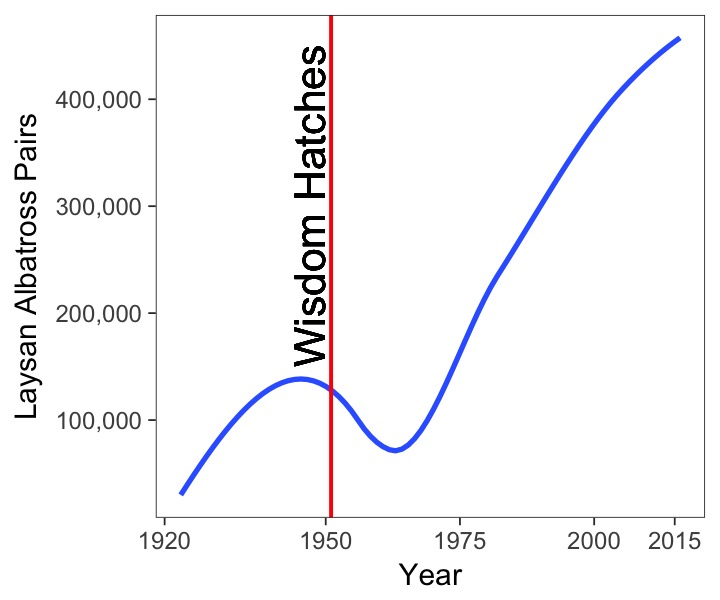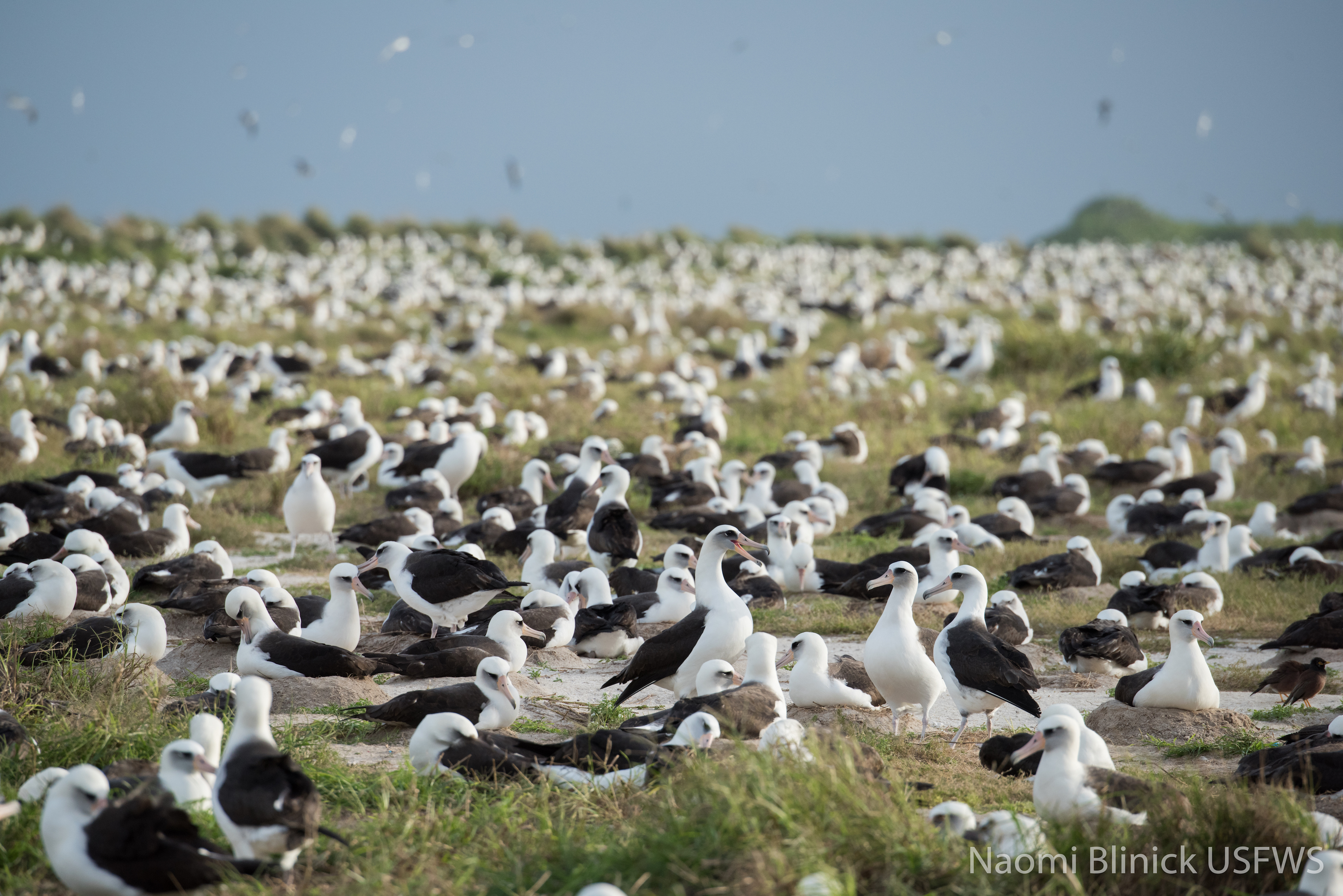By Abram Fleishman, San Jose State University graduate student
Each December my news feeds, from Facebook and Twitter to professional listservs and
mainstream news sources, are inundated by a flood of stories about one bird. Not one
species of bird, but actually a single individual living on one of the most remote islands in one of the most remote archipelagos in the world. A bird that if it was not beautiful, elegant, and most of all old, no one would care about.

Wisdom is a Laysan Albatross that nests on Midway Atoll at the far end of the Hawaiian
archipelago. While part of Hawaii, this is not the tall volcanic tropical paradise you picture when your friend tells you she is going on vacation. Midway is halfway between North America and Japan, an ancient sunken island that now only scratches the surface of the Pacific. Once a bustling military base during WWII, Midway is now a wildlife refuge and home to several million seabirds.
Wisdom was first banded in 1956 by a biologist named Chandler Robbins as part of the Pacific Biological Survey (see her profile here). She was banded as an adult, which means her exact age is not known, but because Laysan Albatrosses do not nest until they are ~5-8 years old, she is at least 66 years old. This makes Wisdom the oldest wild bird ever recorded, which has been the focus of much of the press that she has received. Perhaps just as interesting and impressive is that she has been laying an egg each year (albatrosses only lay a single egg) and even hatched a chick this year at age 66! Her life has been heavily chronicled by researchers, and you can follow along here.
Recently, at the 43 rd Annual Meeting of the Pacific Seabird Group in Tacoma, Washington, I listened to Dr. George Divoky speak about changes he has observed in a colony of Black Guillemots, a small northern seabird, which he has been monitoring since 1970. The changes to the Arctic over his career have been vast: the Arctic summer is now longer (number ice free days) and the ice cover on the Arctic Ocean has decreased, driven by increased temperatures. In other words: Climate Change. We often think of climate change as affecting animals at the population-level: range shifts over decades, or declines over generations. But George pointed out that changes are happening at the individual-level. He used Wisdom as an interesting example, pointing out that she has lived through vast changes to her environment since the 1950s. For example, during Wisdom’s life, CO2 concentrations in the atmosphere have increased to 340% over preindustrial (1700) levels (source). CO2 is recognized as one of the most abundant greenhouse gases directly contributing to increase in the global mean temperature. When you plot the data the pattern is striking. So George got me thinking: what other changes have occurred during Wisdom’s lifetime?


Another key change that Wisdom has experienced is the accumulation of plastic debris in the ocean. When Wisdom hatched in the early 1950s, plastic was just becoming part of daily life. Since that time, global plastic production has increased rapidly, and ever since plastic entered the public domain, it has made its way to the ocean. Plastic’s durability, strength, and lightweight nature — the attributes that make it so appealing to us — also make it persist in the environment. In some parts of the world’s oceans, far removed from population centers along the coasts, there are 6 times more micro-plastics than plankton[1]. As a visual forager, Wisdom has had to learn the difference between this new man-made, potentially toxic substance and her usual food. Albatrosses are not particularly well suited for such decision-making, having to fight millions of years of evolution that point toward the mentality that “if it floats, it’s probably delicious”. Each year thousands of albatross chicks and adults die due to plastic ingestion.

While these two examples show a depressing situation that describes the disturbing impact that humans are having on our planet, not all changes that Wisdom has seen are negative. Midway was once a thriving and strategic military base with over 3,500 people living there during World War II. Before that, a vibrant and destructive demand for albatross eggs (for food), feathers (for women’s fashion) and guano (for fertilizer and explosives) depleted albatross populations across the North Pacific. As a result, albatross populations were smaller when Wisdom was born. Over Wisdom’s lifetime however, Albatrosses on Midway have recovered from a low of ~100,000 pairs in 1956 to ~450,000 pairs counted in 2016.

While it is not all doom and gloom, earth is currently in a state of rapid change. Humans are reconfiguring and short-circuiting the processes that have shaped the planet that we know. The timeframe that we are setting is so much faster then past changes, that what the future holds is unknown. Wisdom has survived, and even thrived, in this environment of change, at least up to now. This gives me hope that the capacity to adapt is large in much of the natural world.

